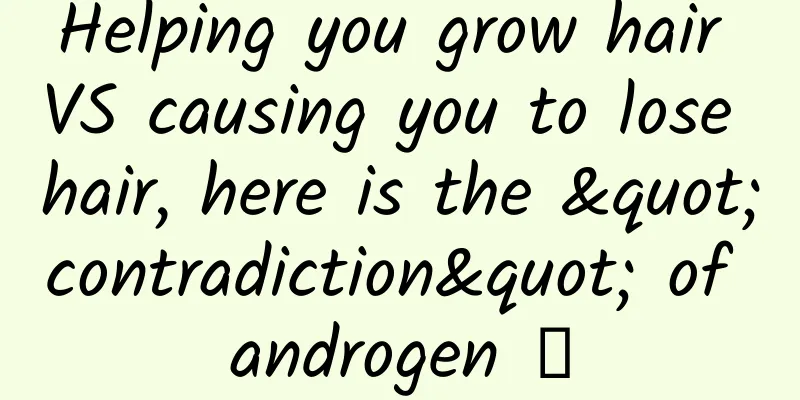Helping you grow hair VS causing you to lose hair, here is the "contradiction" of androgen →

|
When we see someone with abundant body hair, we tend to think that he has a high secretion of androgen; but strangely, there is also a condition called androgenic alopecia, which, as the name suggests, causes hair loss on the head and even baldness. This is a bit contradictory. Why does androgen make hair grow and fall out at the same time? Is one of these two statements wrong? Actually, it is true, but there is a slight difference. Let's talk about it below. 01. Androgens do promote hair growth Too much androgen can cause a significant increase in body hair , especially on the chest, back, arms, legs and buttocks. Excessive androgen can cause the hair in these areas to grow rapidly and become thicker and darker. Because of this, androgen actually has an interesting use. Some transgender people use the androgen testosterone, and then they can quickly grow beards, effectively alleviating their gender identity disorder and confirming their new gender. Secondly, androgens really can cause hair loss. According to the "China Hair Loss Population Survey", the number of people suffering from hair loss in my country has reached 250 million, of which 36% are women and 64% are men. In the past, hair loss mainly occurred in the middle-aged and elderly groups, but in recent years, hair loss has shown a clear trend of younger age. Among the people with hair loss, those born in the 1980s and 1990s account for more than 70%! Among these people with hair loss, the main cause of hair loss is androgen-induced alopecia (AGA, commonly known as male pattern baldness). 02. Why does androgen cause hair loss? It turns out that the androgen in the hair follicles on our forehead and top of the head will produce dihydrotestosterone DHT under the catalysis of 5α-reductase in the hair follicles on the forehead and top of the head. This is the culprit that damages the hair follicles. Once formed, it will continuously attack healthy hair follicles, causing the hair follicles to atrophy, the hair to become thinner and softer, and the growth cycle to shorten, until the hair follicles become necrotic and the hair will no longer grow. This is very interesting. Why is it that the same androgen can cause hair loss on the head, but cause hirsutism in other parts of the body? This can be said to be completely opposite processes. One view currently is that it is related to evolution. A typical example is keratin KRT37, which is the only keratin regulated by androgens. KRT37 is distributed throughout the body in our closest relatives, the chimpanzees, but, oddly, it has not been detected in human hair, but is only distributed in other parts of the body. So we can roughly speculate why chimpanzees can grow hair all over their bodies, while humans can grow hair on the surface of their bodies. However, if there is too much androgen in the top of the head where KRT37 is lacking, it will have the opposite effect. Androgen will be converted into dihydrotestosterone and continue to damage hair follicles, leading to hair loss. I guess you have already got a hidden secret after reading this: since it is a problem of androgen, can't we just get rid of androgen? How to deal with androgen loss? That's right, congratulations, you have discovered the way to deal with androgen loss: target androgen . 03. How to deal with androgens? So is there a way to deal with androgens? Of course there is. The most direct idea is to reduce androgens. So fenandrogen comes in handy. It is a specific inhibitor of 5α-reductase, so it can play a role in the conversion of testosterone to dihydrotestosterone, thereby inhibiting androgen secretion and reducing androgen levels in the body. Because of this, fenandrostenone has a good effect in relieving male pattern baldness in clinical practice and is widely used. However, there is a problem here, which you may have noticed: fenandrostenone targets systemic androgens, but androgens are not only responsible for hair loss, they also have other physiological functions. This treatment will result in the suppression of hair loss, but the normal physiological functions of the body will also be affected, which is troublesome. Because of this, people think, since androgen is a normal hormone in humans, it only causes hair loss on the head, so is it possible to specifically target the androgen on the scalp? The answer is of course yes, so another more widely used ingredient emerged: minoxidil. In fact, minoxidil is a typical case of an old drug with a new use. It is a drug for treating high blood pressure, but during the treatment process, researchers found that minoxidil can cause patients to have excessive hair growth. This side effect has just stimulated people's other expectations: Can minoxidil be used to deal with hair loss? The result is naturally feasible. Applying minoxidil on the scalp can effectively alleviate the problem of androgenetic alopecia and can treat androgenetic alopecia to a certain extent. This makes people happy. On the one hand, minoxidil can treat male pattern baldness. On the other hand, unlike phenadrine, which acts systemically, minoxidil acts on the scalp by applying or spraying, which can effectively reduce its impact on other parts of the body. Therefore, minoxidil has become an important choice for many people to solve the problem of hair loss. However, unlike the principle of fenasteride, the principle of minoxidil in treating hair loss is similar to that of treating hypertension, which is to improve circulation. Specifically, it is to improve the circulation of hair follicles, thereby promoting hair follicle growth. Therefore, there may be some skin irritation during the use of minoxidil. Of course, in the treatment of hair loss, a significant problem of minoxidil is the hair shedding period, which is why many people are a little worried about minoxidil, not to mention that many people are worried about the use of the drug itself. 04. Is there a better way to prevent hair loss? So, is there a better option that can be used only on the scalp and is a more gentle way to prevent hair loss? The answer is yes, that is caffeine. Yes, it is the caffeine in the coffee that everyone is familiar with. Research on caffeine has been ongoing, including the exploration of the mechanism of caffeine. For example, research has found that caffeine plays an important role in cyclic adenosine monophosphate (cAMP). Interestingly, in male baldness, the conversion of testosterone into dihydrotestosterone is also related to cAMP. This is interesting. Both caffeine and androgenic hair loss are related to the cAMP pathway. In fact, caffeine happens to have a countermeasure relationship with androgenic hair loss. Specifically, in the scalp, after androgens are converted into DHT, they consume the cAMP of the cells, which further leads to the miniaturization of hair follicles. Caffeine can increase the cAMP in the cells, so it is a perfect countermeasure. Caffeine/Mechanism of Action In other words, in theory, caffeine can help with testosterone. But is it true? The researchers then conducted a study on the relationship between caffeine and hair, and found that after using caffeine, the rate of hair growth was significantly changed compared to the control group [1]. Caffeine Effects In addition, the effect of caffeine on hair growth has also been confirmed at the application level in the human population. In an experiment using caffeine shampoo, the use of caffeine shampoo significantly improved the condition of the hair. For example, in the hair-pulling test, the caffeine group performed significantly better than the normal group [2]. Caffeine Effects It can be seen that caffeine has the effect of improving hair. Moreover, it is worth mentioning that as a familiar ingredient to the public, caffeine itself is much milder than the drug minoxidil. This can make many people feel more at ease. After all, for most people, facing the common situation of hair loss, there are still many concerns about seeking help from doctors or even using drugs. Caffeine solves this problem well, and ingredients that are familiar to everyone are more easily accepted. Therefore, caffeine began to enter the consumer market for hair loss prevention. Since caffeine is a mild anti-hair loss ingredient, we need to be careful when using it, that is, how to make caffeine gently blend into our scalp to alleviate hair loss problems. For example, in a study on the penetration of caffeine, the pores of the hair follicles in the control group were sealed with wax, while the pores of the hair follicles in the experimental group were left open. It can be seen that after 2 minutes, caffeine penetrated deeply into the stratum corneum and hair follicles [3]. So try to let the shampoo stay on your scalp for 2 minutes before rinsing it off. The purpose of this is to allow caffeine to penetrate into our hair follicles more quickly, and even after being washed off with shampoo, it can remain for a long time. After the subsequent 24 hours, we can still detect caffeine in the hair follicles. This way, the caffeine can penetrate deeper into the hair follicles, open up the nutrient transport system of the hair follicles, and thus play a role in improving the microcirculation of the scalp. Finally, for people with hair loss, any small factor may be a trouble for the fragile scalp. Of course, it needs to be emphasized that hair loss prevention should be viewed scientifically and rationally. Hair loss prevention is a gradual process. It is better to persist in using it for a long time. 2 minutes a day for 2 months is more effective. Of course, some people may ask, if that's the case, does drinking coffee work? This question, back to the original question, the answer is no, because you have to specifically target the scalp. [1]Fischer TW, Hipler UC, Elsner P. Effect of caffeine and testosterone on the proliferation of human hair follicles in vitro[J]. International journal of dermatology, 2007, 46(1): 27-35. [2]Bussoletti C, Mastropietro F, Tolaini MV, et al. Use of a caffeine shampoo for the treatment of male androgenetic alopecia[J]. Journal of Applied Cosmetology, 2010, 28(4): 153. [3]Otberg N. et al.Follicular Penetration of Topically Applied Caffeine via a Shampoo Formulation[J].Skin Pharmacol Physiol.2007;20:195–198. |
<<: Why is the "hairy monster" roaming the Eurasian continent "frozen" underground?
Recommend
How do iOS 12 and Android 9 fight phone addiction?
In iOS 12 and Android 9 Pie, both Apple and Googl...
The 10 key technology keywords in the Government Work Report are very important!
March 5 The fifth session of the 13th National Pe...
Do you have a bad face shape? Maybe you have this bad habit in the past! The earlier you treat it, the less impact it will have.
When looking in the mirror Everyone's face sh...
Apple will truly achieve password-free login. How will it do it?
At the Worldwide Developers Conference (WWDC) hel...
Behind the food that smells bad but tastes good, there is a magical smell "magic"
In the vast world of food, there is a magical phe...
APP promotion tips: 100,000 yuan brings 20 million users
Last time, I wrote an article titled "How to...
The official version of iOS 16.3.1 is here, and several new features will be released soon!
A few days ago, Apple pushed the official version...
How to create an internet celebrity?
This article takes Dyson as an example and analyz...
Fans are productivity. The Internet subverts the rules of the game for Chinese films
For China's traditional big-name directors su...
For modern people who “keep their heads down”, if they suffer from cervical spondylosis, their necks may not necessarily hurt?
Modern people's cervical spine It's reall...
Kunshan Social Insurance Fund Management Center: National Internet Security Management Service Platform!
In order to protect network information security,...
The most comprehensive guide to gamification user growth strategies
01. “AARRR” Theoretical Definition As the penetra...
Methodology in the Internet Age: Where is the trend?
Many people say that we should stand on the wind,...
Perhaps this is the best solution to increase TV ratings: Medium-length videos expand the new blue ocean of large-screen content
For many people born before the millennium, for a...









